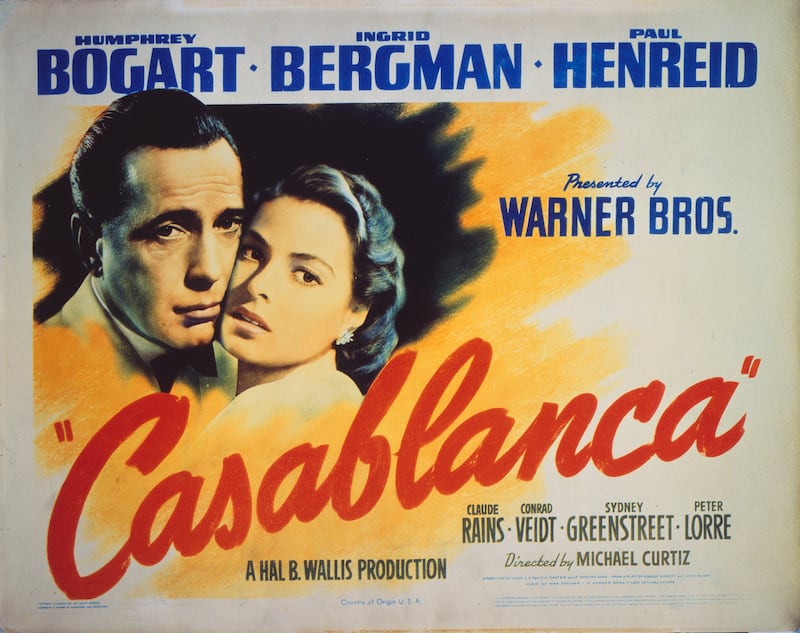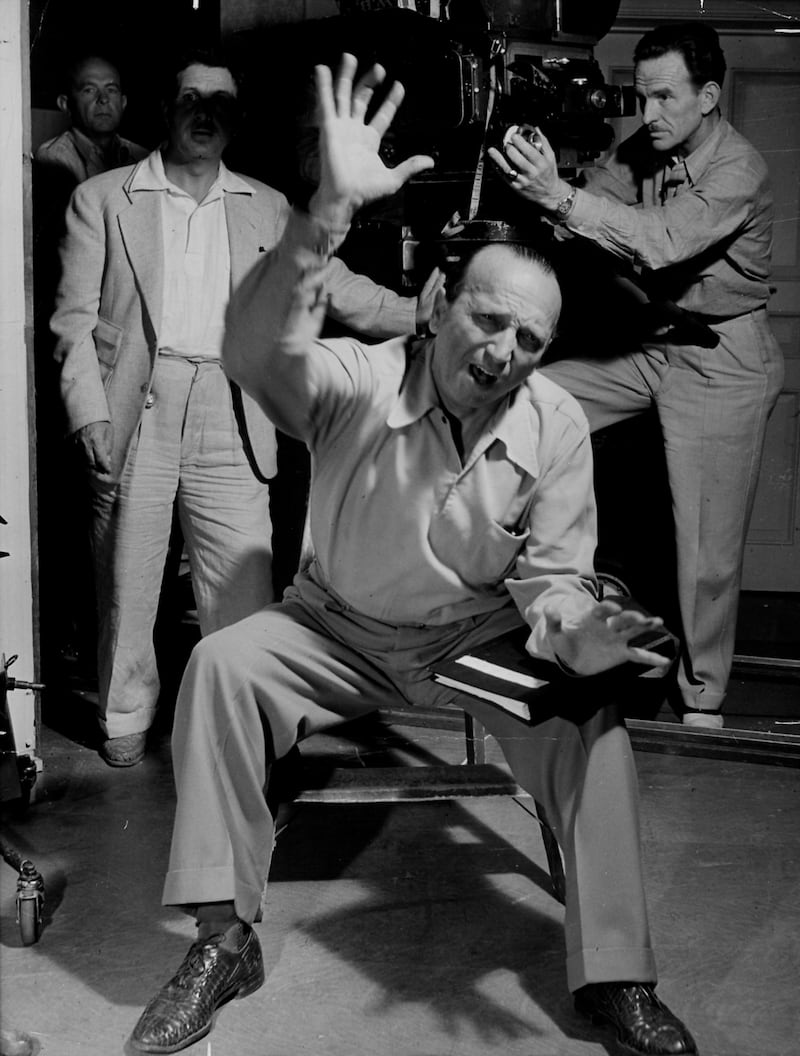In 1974, Warner Brothers executive Simon Benzakein met French New Wave icon François Truffaut in Los Angeles with an offer to remake Casablanca. The director had nothing against the idea of remakes per se but was reluctant to take on a title that carried so "much weight in the history of American cinema".
Upon returning to Paris, Truffaut wrote: “It is not my favourite Humphrey Bogart film, I have a far greater admiration for The Big Sleep or To Have and Have Not. Because of that, I should logically find the idea of directing a new version less intimidating, and I have not forgotten that the film has quite a French atmosphere. I am aware, however, that American students have created a cult around the film, principally its dialogue, which they know by heart. There can be no doubt that most actors would feel as intimidated as I do and I cannot imagine Jean-Paul Belmondo or Catherine Deneuve being willing to step into the shoes of Humphrey Bogart and Ingrid Bergman.”
Warner Bros have made several attempts to reboot Casablanca. In 1943, shortly after the film landed the Best Picture Oscar, Warner Bros announced then renounced plans to release a sequel called Brazzaville based on the "beautiful friendship" between Rick and Capt Renault and the idea that they had secretly been Allied operatives all along.
A short-lived television show in 1955 cast Charles McGraw as Rick Blaine, the role originally played by Bogart. An even shorter-lived prequel series debuted in 1983 featuring Starsky and Hutch’s David Soul as Rick, along with Scatman Crothers and Ray Liotta.
There have been variations: Pamela Anderson in Barb Wire, Woody Allen’s Play It Again, Sam, Looney Toons’ Carrotblanca starring Bugs Bunny as Rick, and a 2009 all-female Japanese musical.
Madonna pitched a remake with her playing Ilsa and Ashton Kutcher playing Rick in the early 2000s. A West End production of the play that Casablanca was based on closed after a month in 1991.
In 2012, a proposed sequel, Return to Casablanca or As Time Goes By, generated dozens of outraged headlines and opinion pieces. No one has seen or heard of the project since.
With every failed revival, it becomes clearer that Casablanca was lightning in a bottle. “It has a life of its own,” said Ingrid Bergman. “There is something mystical about it. It seems to have filled a need, a need that was there before the film.”
An untold number of peculiarities and twists of fate transformed a modestly budgeted studio product into the film Umberto Eco describes as “It is movies”.
Consider the parallel histories.
On January 5th, 1942, The Hollywood Reporter announced that Ann Sheridan and her Kings Row co-star Ronald Reagan had been cast as Ilsa and Rick.
Ilsa and Rick might have had a happy ending had the Motion Picture Production Code not forbidden showing a woman leaving her husband for another man. As Time Goes By would not have featured if it hadn’t been shot as a makeweight number.
As the New Yorker noted in 1942, opening the film less than three weeks after Gen Patton's forces landed in French North Africa and the Casablanca Declaration, ensured that: "General Eisenhower has merely served them well as an advance agent".
Everybody Comes to Rick's, the unproduced play on which Casablanca was based, as written by Murray Burnett and Joan Alison, came across the desk of a studio reader on December 8th, 1941, one day after the Pearl Harbor attack and hours after a studio callout for patriotic projects. Two weeks later, Hal B Wallis, the executive in charge of production, decided to make the film. He changed the location from Vienna and the title to mirror the exoticism of recent studio hit Algiers.

On January 5th, 1942, The Hollywood Reporter announced that Ann Sheridan and her Kings Row co-star Ronald Reagan had been cast as Ilsa and Rick. Reagan, however, was in the US Cavalry Reserve and was soon called into active duty.
Jack L Warner, the head of the studio, then offered the role of Rick to George Raft, but the actor, who also passed on The Maltese Falcon and High Sierra, turned it down. Hedy Lamarr, and Lena Horne were considered for Ilsa.
Finally an approach was made to David O Selznick, who held Bergman’s contract, to lend her to Warner Bros. The rising Swedish star was far from thrilled. She had her heart set on For Whom the Bell Tolls and spent the entire Casablanca shoot waiting for a call that would whisk her away.
She found Bogart intimidating. For all their onscreen chemistry, they hardly spoke, save for a lunch the two had with the Greystones-born actor, Geraldine Fitzgerald. “The whole subject at lunch was how they could get out of that movie,” recalled Fitzgerald. “They thought the dialogue was ridiculous and the situations were unbelievable.”
Paul Henreid, cast to play Victor Laszlo, was even more dismayed. He had just starred opposite Bette Davis in Now, Voyager and was alarmed by the “lousy, lousy script’’. He thought his entrance in cream coloured suit – having supposedly escaped from a concentration camp – was wildly inappropriate.
Despite the coolness between the leads, Bogart’s hard-drinking wife, Mayo Methot, repeatedly accused him of having an affair with Bergman, leaving the actor in a near-permanent rage. There were mounting tensions between studio boss Jack Warner and producer Wallis. There was a script that was still being cobbled together when the film started shooting.
When shooting began, Bergman asked whether her character was supposed to be in love with Rick or Laszlo. Director Michael Curtiz, who did not know, told her to “play it in between”.
The script had a strange evolution, complicated by the temporary departure of screenwriting twins Julius and Philip Epstein to work on Frank Capra’s Why We Fight. Howard Koch, the third credited screenwriter, contributed in their absence. The romantic scenes were shaped by an uncredited Casey Robinson.
“The Epsteins needed Koch to bring in the moral background, and Koch needed the Epsteins to keep things from getting too preachy,’’ claimed Noah Isenberg in his 2016 book We’ll Always Have Casablanca.
Standing at the epicentre of all these ructions was film-maker Curtiz.

A new film simply titled Curtiz and directed by Tamas Yvan Topolánszky, recreates the drama behind the making of Casablanca. Placing the titular director (played by Ferenc Lengyel) as the star, Curtiz downplays Casablanca’s ensemble in favour of the film-maker’s struggles as he juggles competing interests and his own not inconsiderable ego.
A womaniser, a neglectful father, a workaholic, and a Hungarian émigré with endangered family members back in Europe, Curtiz makes for a complicated movie hero.
But Curtiz has always been a complicated hero. As James Cagney who won an Oscar for the Curtiz-directed Yankee Doodle Dandy recalled: “Mike was a pompous b*****d who didn’t know how to treat actors, but he sure as hell knew how to treat a camera.” Olivia de Havilland agreed: “Oh, I guess he was a villain but he was pretty good.” “He can be a real son of a b***h to the bit players,” said Bogart, who threatened to walk off the set of Casablanca.
The director's 'demonic work ethic approached savagery'
Born into a middle class Jewish family in Budapest in 1886, Manó Kaminer – he went through several name changes before settling on Michael Curtiz – trained as an acrobat and an actor before moving behind the camera. He had already made about 70 films for the Hungarian-Austrian film industry before he arrived in the US in 1926.
His knack for high crane shots, German Expressionist tics, and for incorporating romance into historical narratives immediately caught the attention of Jack and Harry Warner. Curtiz would make 94 films during his decades at Warner Bros, earning five director Oscar nominations over an eight-year period.
A restless soul who needed only four hours sleep, Curtiz’s drive led to repeated run-ins with cast and crew. As Alan K Rode notes in Michael Curtiz: A Life in Film (2017) the director’s “demonic work ethic approached savagery”. Working conditions on his sets are said to have inspired the formation of the Screen Actors Guild.
His thick Hungarian accent, “a source of joy” by David Niven’s account, has informed decades of parody and Hollywood lore. A sign hung on the door of Curtiz’s soundstages warning: “Curtiz spoken here”. On the set of Casablanca, the director asked a prop man for a “poodle” to appear in one scene. After an extensive search, the prop man returned and presented a dog to Curtiz, who screamed: “A poodle of water.”
Curtiz worked with everyone from Kirk Douglas to Elvis, on westerns, musicals, swashbucklers, melodramas, weepies, and horror movies. He discovered Errol Flynn and John Garfield. He presided over the canonical Mildred Pierce and White Christmas.
It is impossible to imagine American cinema without him. And yet, he was never a name director in the way that his near contemporaries Capra and John Ford were.
For American film critic Andrew Sarris, Casablanca was the "happiest of happy accidents" and Curtiz "the most divisive exception to auteur theory". In the programme accompanying a 2011 Museum of Modern Art retrospective, Charles Silver wrote of Curtiz: "What can one say about a guy who could follow up The Egyptian with White Christmas, and jump immediately from Francis of Assisi to a John Wayne western?"
Recent scholarship, however, questions the idea that Curtiz was merely an efficient generalist. In Round Up the Usual Suspects: The Making of Casablanca, Aljean Harmetz suggests Curtiz “signed each film in the 1930s with coherent and exciting action within each scene, masking the fact that the heavy cameras could only move slowly and ponderously”.
Writing in The Many Cinemas of Michael Curtiz, Homer Pettey suggests that while Ford is usually given the credit, it can be argued that “Curtiz ushered in the great age of the feature-length western”.
In a 2013 article for Bright Lights Film Journal, Jerry Kutner questions Curtiz’s reputation as a non-artist: “To be considered an auteur, a director must have either a consistently recognisable visual style or recognisable themes . . . There is a recognisable Curtiz visual style, a kind of von-Sternbergian expressionism, but it is mainly visible in his horror films, film noirs, or quasi-noirs.”
Casablanca’s Rick is typical of Curtiz’s repeated subversions of the decisive Hollywood hero. But it wasn’t a typical role for Bogart who, until then, was not considered a romantic lead. It was Curtiz who coaxed the actor around after Bogart arrived on set, declaring: “I’m not up on this love stuff and don’t know just what to do.”
The director had considerable input into the Casablanca ensemble. The cast were mostly immigrants hailing from more than 34 different nations. Many of the actors playing Nazis had, in fact, fled from the Nazis. Hungarian SZ Sakall, who played the head waiter, lost three sisters in the concentration camps. The common language on set was German.
According to Isenberg's book: "Among the 14 [actors] who earned a screen credit, only three were born in the United States: Humphrey Bogart, Dooley Wilson, and Joy Page."
In the famous scene in which Laszlo sings La Marseillaise, one character actor noticed everyone was crying: “I suddenly realised they were all real refugees.”
Curtiz’s Café Américain, the setting for most of the film, is a place to question what it means to be an American.
Curtiz is on Netflix from this weekend





















